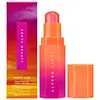Fenty Beauty Match Stix Color-Adaptive Cheek + Lip Stick Versus Lawless Pinch My Cheeks Soft-Blur Cream Blush
What's inside
What's inside
 Key Ingredients
Key Ingredients

 Benefits
Benefits

No benefits
 Concerns
Concerns

 Ingredients Side-by-side
Ingredients Side-by-side

Dimethicone
EmollientIsononyl Isononanoate
EmollientCetearyl Isononanoate
EmollientMica
Cosmetic ColorantTrimethylsiloxyphenyl Dimethicone
Polyethylene
AbrasiveDicalcium Phosphate
AbrasiveLauryl Dimethicone
Skin ConditioningNylon-12
Silica
AbrasivePolymethyl Methacrylate
Dimethicone/Divinyldimethicone/Silsesquioxane Crosspolymer
HumectantPentaerythrityl Tetra-Di-T-Butyl Hydroxyhydrocinnamate
AntioxidantCaprylic/Capric Triglyceride
MaskingCamellia Sinensis Leaf Extract
AntimicrobialCI 77891
Cosmetic ColorantCI 45410
Cosmetic ColorantCI 73360
Cosmetic ColorantDimethicone, Isononyl Isononanoate, Cetearyl Isononanoate, Mica, Trimethylsiloxyphenyl Dimethicone, Polyethylene, Dicalcium Phosphate, Lauryl Dimethicone, Nylon-12, Silica, Polymethyl Methacrylate, Dimethicone/Divinyldimethicone/Silsesquioxane Crosspolymer, Pentaerythrityl Tetra-Di-T-Butyl Hydroxyhydrocinnamate, Caprylic/Capric Triglyceride, Camellia Sinensis Leaf Extract, CI 77891, CI 45410, CI 73360
 Reviews
Reviews

Ingredients Explained
These ingredients are found in both products.
Ingredients higher up in an ingredient list are typically present in a larger amount.
CI 45410 is a synthetic red-pigment and dye.
It often goes by both Red 28 or Red 27; manufacturers label both ingredients as CI 45410.
This dye is commonly found in makeup because it imparts a vivid color. Some types of this dye change color based on pH level and interaction with moisture:
Your skin has a natural pH of around 4.5 - 5.5.
According to the FDA, CI 45410 is not permitted for use in eye products.
Red 27 is a flourescein dye and commonly used as a fluorescent tracer in medicine.
Learn more about CI 45410Mica is a naturally occurring mineral used to add shimmer and color in cosmetics. It can also help improve the texture of a product or give it an opaque, white/silver color.
Serecite is the name for very fine but ragged grains of mica.
This ingredient is often coated with metal oxides like titanium dioxide. Trace amounts of heavy metals may be found in mica, but these metals are not harmful in our personal products.
Mica has been used since prehistoric times throughout the world. Ancient Egyptian, Indian, Greek, Roman, Aztec, and Chinese civilizations have used mica.
Learn more about MicaSilica, also known as silicon dioxide, is a naturally occurring mineral. It is used as a fine, spherical, and porous powder in cosmetics.
Though it has exfoliant properties, the function of silica varies depending on the product.
The unique structure of silica enhances the spreadability and adds smoothness, making it a great texture enhancer.
It is also used as an active carrier, emulsifier, and mattifier due to its ability to absorb excess oil.
In some products, tiny microneedles called spicules are made from silica or hydrolyzed sponge. When you rub them in, they lightly polish away dead skin layers and enhance the penetration of active ingredients.
Learn more about Silica